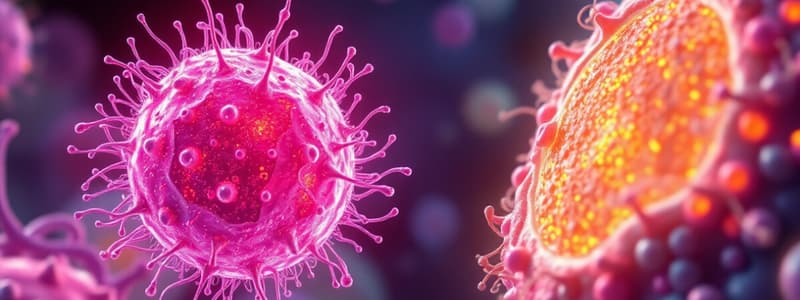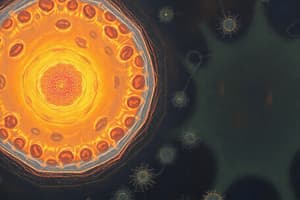Podcast
Questions and Answers
Which cell structure is responsible for the production of ATP?
Which cell structure is responsible for the production of ATP?
- Golgi Apparatus
- Mitochondria (correct)
- Lysosomes
- Endoplasmic Reticulum
What is the main function of the rough endoplasmic reticulum?
What is the main function of the rough endoplasmic reticulum?
- Protein synthesis (correct)
- Lipid synthesis
- Intracellular digestion
- Sorting and packaging proteins
Which of the following best describes the main function of the Golgi apparatus?
Which of the following best describes the main function of the Golgi apparatus?
- Intracellular digestion
- Synthesis of lipids
- Production of ATP
- Sorting and packaging of proteins (correct)
Which of these statements accurately describes the role of the nucleus?
Which of these statements accurately describes the role of the nucleus?
What distinguishes plant cells from animal cells in terms of cell structure?
What distinguishes plant cells from animal cells in terms of cell structure?
Which of the following statements accurately describes prokaryotic cells?
Which of the following statements accurately describes prokaryotic cells?
According to the endosymbiotic theory, what is the origin of mitochondria and chloroplasts (plastids)?
According to the endosymbiotic theory, what is the origin of mitochondria and chloroplasts (plastids)?
What evidence supports the endosymbiotic theory?
What evidence supports the endosymbiotic theory?
Which of the following best describes the Colonial Flagellate Hypothesis?
Which of the following best describes the Colonial Flagellate Hypothesis?
According to the provided text, what is the basic unit of life structure?
According to the provided text, what is the basic unit of life structure?
What does the text imply about the relationship between structure and function in biological systems?
What does the text imply about the relationship between structure and function in biological systems?
How are animal cells classified?
How are animal cells classified?
Why were the first cells that were not adapted to oxygen?
Why were the first cells that were not adapted to oxygen?
A cell's ability to efficiently exchange materials is most directly limited by its:
A cell's ability to efficiently exchange materials is most directly limited by its:
Which of the following best describes the arrangement of phospholipids in a cell membrane?
Which of the following best describes the arrangement of phospholipids in a cell membrane?
What role do transmembrane proteins play in a cell membrane?
What role do transmembrane proteins play in a cell membrane?
What is the main distinction between simple diffusion and facilitated diffusion across a cell membrane?
What is the main distinction between simple diffusion and facilitated diffusion across a cell membrane?
How does active transport differ from passive transport mechanisms like diffusion and facilitated diffusion?
How does active transport differ from passive transport mechanisms like diffusion and facilitated diffusion?
What is the primary function of desmosomes?
What is the primary function of desmosomes?
What is the main role of gap junctions between adjacent cells?
What is the main role of gap junctions between adjacent cells?
What is the main function of the cytoskeleton within a cell?
What is the main function of the cytoskeleton within a cell?
Flashcards
What are prokaryotic cells?
What are prokaryotic cells?
Prokaryotic cells are simple cells lacking a nucleus and other membrane-bound organelles. They are found in bacteria and archaea.
What is the endosymbiotic theory?
What is the endosymbiotic theory?
The endosymbiotic theory explains the origin of mitochondria and chloroplasts in eukaryotic cells. It suggests that these organelles were once free-living prokaryotes that were engulfed by larger cells.
What are mitochondria?
What are mitochondria?
Mitochondria are organelles found in eukaryotic cells responsible for generating energy through cellular respiration.
What are chloroplasts?
What are chloroplasts?
Signup and view all the flashcards
What is the Colonial Flagellate Hypothesis?
What is the Colonial Flagellate Hypothesis?
Signup and view all the flashcards
What are animal cells?
What are animal cells?
Signup and view all the flashcards
What is the relationship between structure and function in animal cells?
What is the relationship between structure and function in animal cells?
Signup and view all the flashcards
What are tissues?
What are tissues?
Signup and view all the flashcards
What is the nucleus?
What is the nucleus?
Signup and view all the flashcards
What are the roles of the endoplasmic reticulum?
What are the roles of the endoplasmic reticulum?
Signup and view all the flashcards
What are lysosomes?
What are lysosomes?
Signup and view all the flashcards
What are the key differences between plant and animal cells?
What are the key differences between plant and animal cells?
Signup and view all the flashcards
Cell Membrane
Cell Membrane
Signup and view all the flashcards
Diffusion
Diffusion
Signup and view all the flashcards
Facilitated Diffusion
Facilitated Diffusion
Signup and view all the flashcards
Active Transport
Active Transport
Signup and view all the flashcards
Desmosomes
Desmosomes
Signup and view all the flashcards
Gap Junctions
Gap Junctions
Signup and view all the flashcards
Cytoplasm
Cytoplasm
Signup and view all the flashcards
Cytoskeleton
Cytoskeleton
Signup and view all the flashcards
Study Notes
Prokaryotic Cells
- Animal cells are eukaryotic.
- The first type of cell is prokaryotic, these still exist today and include most bacteria in the gut and environment.
- Prokaryotic cells are microscopic.
Theory from Prokaryotic to Eukaryotic Cells
- The endosymbiotic theory explains the transition from prokaryotic to eukaryotic cells.
- It explains how mitochondria and chloroplasts originated.
- Endosymbiosis involves two independent cells: one anaerobic (doesn't need oxygen) and one aerobic (needs oxygen).
- In the past, oxygen was toxic to many cells and absent.
- The theory suggests that an anaerobic cell engulfed an aerobic cell, without digesting it.
- Over time, the engulfed cell adapted and lived inside the other cell.
- This explains the origin of mitochondria and plastids in eukaryotic cells.
- Evidence for this includes double membranes in these organelles, and they each have their own genetic material.
- Most animal cells do not have chlorophyll, but some deep-sea creatures do.
From Unicellular to Multicellular Organisms
- All animals are multicellular but early organisms were unicellular.
- The Colonial Flagellate Hypothesis suggests that cells joined for mutual benefit.
- Some cells specialized, for example in nutrient gathering or reproduction.
- These specialized cells eventually became interdependent.
Animal Cell Structure and Function
- Cells are the basic unit of life.
- Cell structure is related to its function.
- Thin tissues aid in diffusion, while thicker tissues are for secretion.
- This relationship is essential to understanding biology.
Surface Area to Volume Ratio
- Cells can be thought of as shapes.
- The outer membrane = surface area.
- Everything inside the cell = volume.
- A larger surface area allows for faster exchange of materials (oxygen, waste), essential for cell function.
- Larger organisms need more cells to maintain efficiency.
Cell Membrane
- The outer boundary of a cell.
- It's a phospholipid bilayer.
- Hydrophobic molecules face inward.
- Hydrophilic molecules face outward.
- The membrane is fluid, allowing it to adjust.
- Some proteins help with transport and cell recognition.
- Carbohydrates serve as a "name tag" for cell recognition.
- The cell membrane is selectively permeable.
Membrane Transport
- Diffusion: Small molecules move from high to low concentration.
- Facilitated diffusion: Larger molecules use channels to pass through.
- Active transport: Requires energy (ATP), to move molecules against their concentration gradient.
Cell Junctions
- Desmosomes: Cell-to-cell connectors for structural support.
- Gap junctions: Channels between cells allowing material exchange rapidly.
Inside the Cell
- Cytoplasm fills the cell.
- Hydrophilic regions are exposed to the cytoplasm.
- Cytoskeleton helps create cell structure and movement.
Centrosome
- Involved in cell division and unique to animal cells.
Nucleus
- The control center of the cell.
- Contains genetic material (DNA).
DNA and RNA
- DNA directs protein production.
- During cell division, genetic information is copied.
- RNA is translated into protein, leaving through nuclear pores in the nucleus.
Endoplasmic Reticulum
- The rough ER has ribosomes involved in protein synthesis.
- The smooth ER is not associated with ribosomes and involved in lipid synthesis.
Golgi Apparatus
- Sorts proteins, packages them, and sends them to their destination.
Lysosomes
- Found mostly in animal cells.
- Help in intracellular digestion.
- Recycles cell components.
Mitochondria
- Powerhouse of the cell.
- Generates energy (ATP).
- Evidence of endosymbiosis, it has its own genetic material and ribosomes.
Cell Walls and Membranes
- Plant cells have cell walls (rigid).
- Animal cells have flexible membranes.
Studying That Suits You
Use AI to generate personalized quizzes and flashcards to suit your learning preferences.




